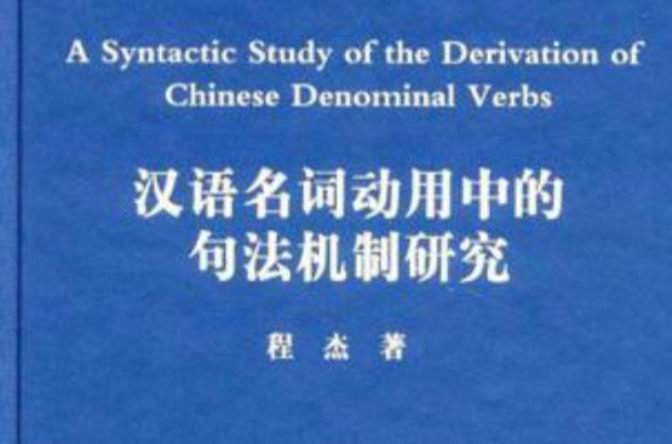圖書信息
外文書名: A Syntactic Study of the Derivation of Chinese Denominal Verbs
精裝: 337頁
正文語種: 英語, 簡體中文
開本: 16
ISBN: 703027928X, 9787030279286
條形碼: 9787030279286
尺寸: 21.2 x 14.4 x 2.2 cm
重量: 522 g
內容簡介
《漢語名詞動用中的句法機制研究》內容簡介:Chinese denominal verbs (DNVs for short) are amenable to an L-syntactic analysis, which is accommodated in a theoretical framework that comprises an overt syntactic operation and two light syntactic categories. The former is V-bar pied-piping, i.e. the head V, when it raises, may optionally pied-pipe its Complement, but stranding the Specifier of its Complement. The operation works as an alternative to the standard way for verb movement under certain licensing conditions and enjoys extensive empirical support. The latter includes proto-verbs,which we separate from categories such as the CFC v and auxiliary verbs, and null prepositions, which, in our argument, may mediate between an intransitive verb and a nominal phrase following it.
目錄
序
Acknowledgements
Abstract
摘要
Glossary
Chapter 1 Introduction
1.1 Introduction
1.2 Denominal Verbs in Chinese
1.2.1 The Criteria
1.2.2 The Data
1.2.3 Semantic Properties of DNVs
1.3 Previous Approaches to DNVs
1.3.1 The Lexical/Morphological Approach
1.3.2 The Pragmatic Approach
1.3.3 The Lexical-semantic Approach
1.3.4 The Syntactic Approach
1.3.5 Summary
1.4 Rationale for This Research and Questions to Be Addressed
1.5 A Syntactic Approach to Chinese DNVs: An Overview
Chapter 2 The V-bar Pied-piping Hypothesis
2.1 Introduction
2.2 The V-bar Pied-piping Hypothesis
2.2.1 Dative Shift Under Current Theories on Verb-related Movement
2.2.2 The V' Reanalysis Hypothesis
2.2.3 The V-bar Pied-piping Hypothesis
2.2.4 Licensing V-bar Pied-piping
2.3 Explaining Some (A)symmetries of Syntactic Domains
2.4 Explaining Some Natural Word Order Phenomena
2.4.1 Adjuncts
2.4.2 Verb Particles
2.4.3 Extraposition
2.4.4 Inversion
2.5 Deriving Compound Verbs in Chinese
2.5.1 Verb-Directional/-Phase Constructions in Chinese
2.5.2 Verb-Resultative Constructions in Chinese
2.5.3 Light Verb Constructions in Chinese
2.6 Summary
Chapter 3 Semantic Light Categories in Chinese
3.1 Introduction
3.2 Light Verbs: Syntactic vs. Semantic
3.2.1 The Meanings of Light Verb
3.2.2 Light Verb v vs. Proto-verbs
3.2.3 Proto-verbs vs. Canonical Verbs
3.2.4 Auxiliary Verbs
3.3 Null Prepositions in Chinese
3.3.1 Variety and Unselectiveness of Verbal Objects
3.3.2 The Null Preposition Hypothesis
3.3.3 Some Consequences
3.4 Summary
Chapter 4 Syntactic Derivation of DNVs
4.1 Introduction
4.2 Reclassifying DNVs in Chinese
4.2.1 Aspectual Classes of Verbs
4.2.2 Aspectual Classes of Chinese DNVs
4.3 Deriving DNVs via Syntax
4.3.1 Deriving Sta-DNVs
4.3.2 Deriving Ach-DNVs
4.3.3 Deriving Acc-DNVs
4.3.4 Deriving Act-DNVs
4.4 Summary
Chapter 5 Syntax-Induced Properties of DNVs
5.1 Introduction
5.2 The Inter-Class Quantitative Asymmetry
5.3 The Inter-Categorical Asymmetry
5.4 The Pattern of Aspectual Shift with DNVs
5.4.1 State-to-Achievement Shift
5.4.2 Achievement-to-Accomplishment Shift
5.4.3 Accomplishment-to-Achievement Shift
5.4.4 Achievement-to-State Shift
5.4.5 Some Caveats
5.5 Accomplishment Verbs in Chinese
5.5.1 The Traditional View
5.5.2 Object-coerced Accomplishment Verbs
5.5.3 Syntactically-derived Accomplishment Verbs
5.6 Determination of the Aktionsart of DNVs
5.6.1 Definiteness of Objects
5.6.2 Boundedness of Objects
5.6.3 Boundedness of Source Nouns
5.6.4 Proto-verbs
5.7 Eventuality Structure of DNVs
5.7.1 The Singular-headedness of Sta- and Act-DNVs
5.7.2 The Double-headedness of Ach-DNVs
5.7.3 The Triple-headedness of Acc-DNVs
5.8 Semantic Generation of DNVs
5.8.1 The Basics of Generative Lexicon
5.8.2 Generating the Semantics of Sta-DNVs
5.8.3 Generating the Semantics of Ach-DNVs
5.8.4 Generating the Semantics of Acc-DNVs
5.8.5 Generating the Semantics of Act-DNVs
5.8.6 Functioning of Proto-verbs
5.9 Summary
Chapter 6 A Comparative Perspective on DNVs
6.1 Introduction
6.2 Asymmetries Between Chinese and English DNVs
6.2.1 Quantitative Asymmetry
6.2.2 Typological Asymmetry
6.2.3 Aspectual Asymmetry
6.3 Potential Parametric Variations
6.3.1 Activity vs. Inertness of Null Preposition P
6.3.2 Prominence vs. Dormancy of Proto-verbs
6.3.3 Applicability of V-bar Pied-piping
6.4 The Account for the Asymmetries
6.4.1 Explaining the Quantitative Asymmetry
6.4.2 Explaining the Typological Asymmetry
6.4.3 Explaining the Aspectual Asymmetry
6.5 Summary
Chapter 7 A Diachronic Perspective on Chinese DNVs
7.1 Introduction
7.2 Characteristics of Classical Chinese DNVs
7.3 Light Categories and V-bar Pied-piping in Classical Chinese
7.3.1 Null Prepositions in Classical Chinese Syntax
7.3.2 Proto-verbs in Classical Chinese Syntax
7.3.3 V-bar Pied-piping in Classical Chinese Syntax
7.3.4 Classical Chinese DNVs: A Paradox
7.4 A Minimalist Account
7.4.1 Patterns of Feature Bundling
7.4.2 Strength of Morphemes
7.4.3 The Account
7.5 The Extension of Light Categories from Syntax to Morphology
7.5.1 The Denominal Prefix *s- in Early Archaic Chinese
7.5.2 The Denominal Falling Tone in Middle Archaic Chinese
7.5.3 Denominal Light Categories in Modem Chinese
7.6 Summary
Chapter 8 Concluding Remarks
8.1 Major Findings
8.2 Limitations
Appendix
References

